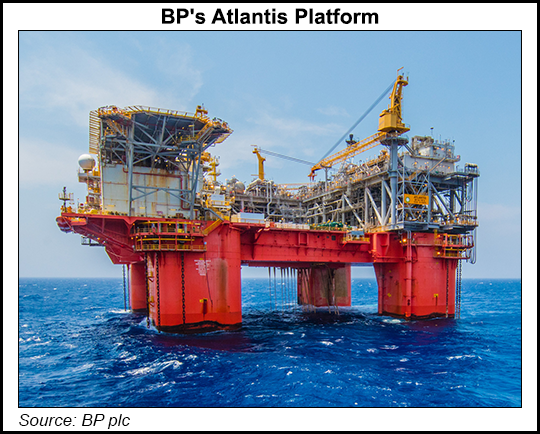E&P | NGI All News Access | NGI The Weekly Gas Market Report
BP Sanctions Atlantis Expansion in GOM, Hits Pay in Two More Discoveries
A $1.3 billion expansion has been sanctioned by BP plc for its deepwater Atlantis field in the Gulf of Mexico (GOM), with “significant additional oil resources” identified by the supermajor that could expand development opportunities around all of its offshore U.S. production hubs.

The Atlantis Phase 3 development is the latest example of BP’s strategy to expand its advantaged output through existing production facilities. Approving the expansion came after BP’s recent breakthroughs in advanced seismic imaging and reservoir characterization, which unearthed an additional 400 million bbl of oil in place (OIP) in the Atlantis field.
CEO Bob Dudley last fall had said BP needed to continue investing, “not to find and produce as much as we can, but to access the most advantaged new barrels that will be needed to make up for declines.”
BP, which operates and holds a 56% stake in Atlantis, partners with BHP, which is expected to soon make a final investment decision about participating in the expansion.
Last year, applying the same technology and analysis used in the Atlantis field identified an additional 1 billion bbl of OIP at the Thunder Horse deepwater field, where an expansion was sanctioned last fall. Elsewhere, two discoveries near the Na Kika deepwater production facility may provide further tie-back development opportunities.
Besides Atlantis, Thunder Horse and Na Kika, BP also operates the Mad Dog platform in the GOM deepwater.
“BP’s Gulf of Mexico business is key to our strategy of growing production of advantaged high-margin oil,” upstream CEO Bernard Looney said. “We are building on our world-class position, upgrading the resources at our fields through technology, productivity and exploration success.
“And these fields are still young — only 12% of the hydrocarbons in place across our Gulf portfolio have been produced so far. We can see many opportunities for further development, offering the potential to continue to create significant value through the middle of the next decade and beyond.“
Atlantis Phase 3 is to include a new subsea production system from eight new wells that would be tied into the current platform, 150 miles south of New Orleans. Scheduled to come onstream in 2020, the project is expected to boost output at the platform by an estimated 38,000 boe/d gross at its peak. Phase 3 also would access the eastern area of the field, where the advanced imaging and reservoir characterization identified additional oil in place.
“Atlantis Phase 3 shows how our latest technologies and digital techniques create real value — identifying opportunities, driving efficiencies and enabling the delivery of major projects,” regional GOM/Canada President Starlee Sykes said. “Developments like this are building an exciting future for our business in the Gulf.”
Proprietary algorithms developed at BP’s Subsurface Technical Center in Houston were applied on a seismic data run at its Center for High Performance Computing, which opened in 2013 as one of the largest supercomputers in the world dedicated to commercial research. The Technical Center specializes in advanced seismic imaging and enhanced oil recovery.
The proprietary algorithms enhance a seismic imaging technique known as full waveform inversion, or FWI, allowing seismic data that would have previously taken a year to analyze to be processed in only a few weeks.
Following a successful field trial at the Mad Dog field, further advanced seismic imaging with ocean bottom nodes and BP’s proprietary Wolfspar seismic acquisition source is being planned for Thunder Horse and Atlantis to better understand the reservoirs. Wolfspar uses ultra-low frequencies during seismic surveys, allowing geophysicists to see deeper below salt layers and enabling better planning of where to drill wells.
More Mississippi Canyon Discoveries
BP on Tuesday also announced two deepwater discoveries in Mississippi Canyon (MC) blocks at the Manuel and Nearly Headless Nick prospects. The Manuel discovery is in MC Block 520, east of the Na Kika platform, where the well encountered oil pay in Miocene sandstone reservoirs. BP, which partners 50-50 in the Manuel field with Royal Dutch Shell plc, expects the reservoir to be developed via subsea tieback to Na Kika.
BP has a 20.25% stake in the Nick discovery in MC Block 387, operated by LLOG Exploration Co. The well encountered oil pay also in Miocene sandstone and is expected to be tied back to the nearby LLOG-operated Delta House facility. Partners in the prospect also include Kosmos Energy Ltd. and Ridgewood Energy.
Since 2013, when BP’s GOM net production was under 200,000 boe/d, its net output has increased by 60%-plus to more than 300,000 boe/d. BP is forecasting GOM production will hit around 400,000 boe/d into the mid-2020s.
Growth from the deepwater would be supported by three Thunder Horse expansions: Northwest, South and a water injection project. BP also has a second platform, Argos, underway at Mad Dog, “which is on budget and on schedule to come online in late 2021,” management said.
“Future potential developments at BP’s offshore fields in the Gulf include Atlantis Phase 4 and 5, further developments at Thunder Horse, Na Kika subsea tiebacks and Mad Dog field extensions.”
© 2024 Natural Gas Intelligence. All rights reserved.
ISSN © 1532-1231 | ISSN © 2577-9877 | ISSN © 1532-1266 |
